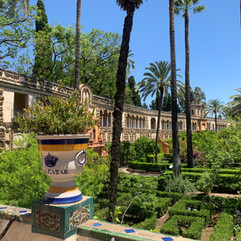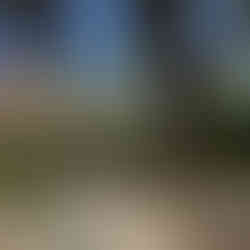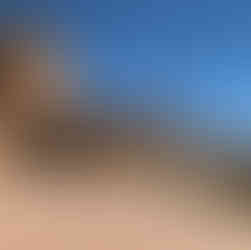Seville in 36 hours - from Portugal to Spain
- Vanessa Valenti

- 5 feb 2022
- Tempo di lettura: 8 min
Aggiornamento: 19 mar 2022
We got to Seville from Portugal, specifically from Faro, after a week on the road starting from the north of Portugal. This beautiful Spanish city was added to our itinerary simply to be able to fly to Lanzarote, ending with 36 hours to explore it.

If you are interested in our journey from the beginning, I leave you the links below to read about the first stops:
- Algarve
Seville, located in the southwestern part of the Iberian Peninsula, in Andalucia, sits on the banks of the Guadalquivir River. Seville is flamenco, tapas, bullfighting, parties, everything that embodies the essence of Spain. The climate is Mediterranean with mild winters and hot summers: with an average annual temperature of around 18.5 ° C, it's one of the warmest cities in Europe. In July, the hottest month, it's not uncommon for maximum temperatures of 40°C. We went right in July and I guarantee you that the heat was intolerable, luckily we were there for little hours. Seville is the perfect destination all year round but I highly recommend you avoid summer: it's difficult to enjoy the city in the scorching summer heat.
We reached Seville via Flixbus. The crossing is cheap and fast, to find out more about the means and travel, I refer you to the specific link with all my tips, and now let's go directly to discover this wonderful city.
Monday 07.05.2021

We left Faro early on Monday morning and got to Seville bus station just before lunch. The hot situation immediately got rough: at noon there were 38 degrees, and I assure you that walking through the streets in the sun was not easy. Eventually, we had just under 36h in the city and we were determined to enjoy them to the fullest and exploit them as much as possible. We headed on foot to the hotel, passing through Plaza Nueva, which is located in the Casco Antiguo district, the commercial and administrative heart of the city, where the Town Hall is also located. It's a modern, large square decorated with a white pavement in line with the surrounding buildings and monuments. In less than 10 minutes on foot we arrived at the hotel, and what a hotel you guys! Paid really nonsense, we found ourselves in the very center of Seville, literally in front of the Cathedral (for info on accommodation click here in the dedicated post). After checking in, packing your bags, and freshening up on the fly, we immediately left for Seville.

Time was short, so we chose only the main stops, the closest and most significant things in the city. A few meters from the hotel we immediately ended up on Plaza del Triunfo, located among the most significant buildings in the city: the Giralda, the Cathedral, Alcázar and the General Archive of the Indies, declared a World Heritage Site by UNESCO in 1987.

We had a great start, with a visit to the Reales Alcazares, for € 13.5 each: money well spent, the building is splendid and majestic, in a very rich Arabian style, full of gold and azulejos. The Reales Alcázares (royal fortresses) include beautiful halls, rooms and courtyards of the palaces, as well as huge gardens with fountains and kiosks. Characteristic of these buildings is the mixture of styles and decorations, ranging from Islamic to Neoclassical. From the Palace you can directly access the Alcazar Gardens, which are also included in the ticket price. Inside the palaces you will also find an exhibition of azulejos that can be visited for free. Small curiosity for fans: the palace was used for the filming of the Throne of Swords, for the "Royal Palace of Dorne".

Upon exiting the Reales Alcazares, we headed towards the Barrio Santa Cruz, where we first stopped in a small bar for a cold beer, to recover a few minutes from the heat. The Barrio Santa Cruz is one of the most picturesque and famous neighborhoods: located in the center, it is the area of the city that most of all has maintained its Moorish structure; following the expulsion of the Arabs, the Jewish community settled here. It's a maze of narrow and quiet streets and squares overlooked by splendid houses with facades covered with ivy and flowers. This neighborhood is also ideal for your evenings, here you will find many places where you can enjoy tapas or an after dinner drink.

After that we walked towards the Guadalquivir river, on whose banks there is the Tower of Gold which, together with the Giralda, is the most emblematic monument of Seville. It's an ancient surveillance tower built in the 13th century to control navigation on the river and it seems that its name comes from the fact that it was once covered with gilded tiles. Currently the tower houses the Naval Museum, which we did not go to, because we kept on towards the Parque de Maria Luisa.
It's the most beautiful park in Seville and it came from the donation, made to the city in 1893, of half of the gardens of the San Telmo Palace, which were owned by Princess Maria Luisa. Here we stopped for a few minutes on a bench in the shade, drinking liters of water and a slush, to try not to get dehydrated. The hot situation was somewhat intolerable: I reiterate the advice to avoid planning your trip to Seville in the height of summer, better the mid-seasons.

Passing through the park, we finally got to Plaza de Espana, within the park itself. Very famous, perhaps the emblem of the city, it's a huge semicircle square that culminates in two high towers at the ends, the North and the South. The square represents the embrace of Spain towards its ancient colonies. It looks towards the Guadalquivir River and symbolizes the way forward for America. In the center there's a navigable canal with four bridges representing the four ancient kingdoms of Spain. Leaning against the walls there's a series of benches and ceramic ornaments that form spaces that allude to the forty-eight Spanish provinces (they are placed in alphabetical order); on them are represented maps, mosaics depicting historical events and the coats of arms of 48 provincial capitals. The design of the square was launched in honor of the Ibero-American Exposition in Seville in 1929. The whole is truly majestic and breathtaking, you could look at it forever. The square was also the filming location for the Star Wars film Attack of the Clones (episode II) for the "Royal Palace of Naboo".

From here, we went back to the center to attend a Flamenco show. A few days earlier I had received by email, from the hotel where we stayed, a free-entrance for a person for the show for which we decided to take advantage of. Flamenco is music, art, song, dance, poetry, sentiment ... without a doubt the purest expression of Andalusian folklore. Its origins date back to the 15th century, with the arrival of the gypsies in the countryside around Cadiz, from Jerez to Seville. In Seville every day it is possible to attend beautiful flamenco performances in the famous tablaos flamencos - direct heirs of the ancient café-concerts - and in many clubs. We went to the Tablao Alvarez-Quintero where, thanks to the hotel gift, we spent only € 18 in total, which is the price of the one person ticket. The show was at 6pm, but there was a second one at 8pm; it's usually very popular, so I recommend that you book in advance, also because the place is quite small. It all lasts an hour and you will attend various flamenco ballets and a performance of singing and guitar by artists that change from season to season. At the beginning we were a bit perplexed by the particularity of the show, but in the end I would say I absolutely loved it. Definitely an unmissable experience if you are in Seville.
By now it was time for dinner so we headed to Sanedrin Tapas, a very friendly place where Enri had already been on a previous trip and where he absolutely wanted to return. A place also popular with locals, here you can enjoy many different tapas at great prices, both meat and fish, as well as many dishes of the day. After dinner, we went back to the hotel, always crossing Plaza Nueva and indulging in an ice cream while walking. We were quite exausted by the kilometers on foot and the heat, which even at 10.30pm did not allow much respite.
Tuesday 07.06.2021
Packed up in order to be ready for the early afternoon, we left early in order to make the most of the morning in the city as in the late afternoon we had a new flight to catch.

We started the day with a rich breakfast at la Canasta, a very famous pastry shop just below our hotel, in front of the Cathedral. After that, thanks to a genious Enrico, we went visiting the Cathedral during mass time, in order to enter for free (very unconventional but very Italian, I know, but we are not really passionate about churches, but we could not fail to do a jump). The Cathedral of Seville is the largest in Spain and the third in the Christian world after Saint Peter in Rome and Saint Paul in London. It was built on the site of the great mosque of which only the Giralda and the Patio de los Naranjos remain. The main facade is located along Avenida de la Constitución and on the outside surrounded by steps. The interior is impressive and you can find the mausoleum of Christopher Columbus. The Giralda instead, from its 103 meters high, it's the ancient minaret of the mosque which later became the bell tower of the cathedral and it's now the symbolic monument of Seville. From this tower in the Moorish period the muezzin called the faithful to pray and most likely it was also used as an astronomical observatory. La Giralda owes its name to the statue of the Faith (called Giraldillo) that dominates it. From inside the Cathedral you can access a platform, located at the top of the tower, from which you can admire the whole city from above if you have time, certainly the view must be spectacular.

However, we kept going towards Casa de Pilatos, paying € 10 each to enter: perhaps a bit disproportionate in comparison to the price of the Reales Alcazares, but still a spectacular and very rich building. Casa de Pilatos, located in the square of the same name, it's the most sumptuous palace in Seville built in the early 16th century. The idea was to make a copy of Pontius Pilate's Praetorium; the palace is a collection of architectural styles. Included in the price you will be given an audio guide that we have set up in Italian, allowing you to hear some explanations of the various rooms and gardens. In some places we have accelerated a bit because I guarantee you that it would take you hours and hours to hear everything. We were in a bit of a hurry, so we didn't stop for more than an hour.

The last stop on our short visit to Seville was the Metropol Parasol, more commonly known as Setas de Sevilla. It is a modern structure in the shape of a wooden pergola in the Plaza de la Encarnaciòn. At its base you will find a traditional market and ground floor restaurants, a performance hall and the Antiquarium archaeological museum. The structure is crowned by a terrace and a belvedere offering a panoramic view of the old town.

Around lunchtime we went back to the hotel stopping for the last paella in Barrio Santa Cruz, then running to retrieve the luggage we had left at the hotel and we walked towards the Golden Tower where we took the bus to the airport to take a flight for the last leg of our journey: Lanzarote.
In case I have forgotten something or you need more information commented below, I will be happy to help you!
P.s: if you travel to these areas let me have your feedback!
Have a nice trip (:



















